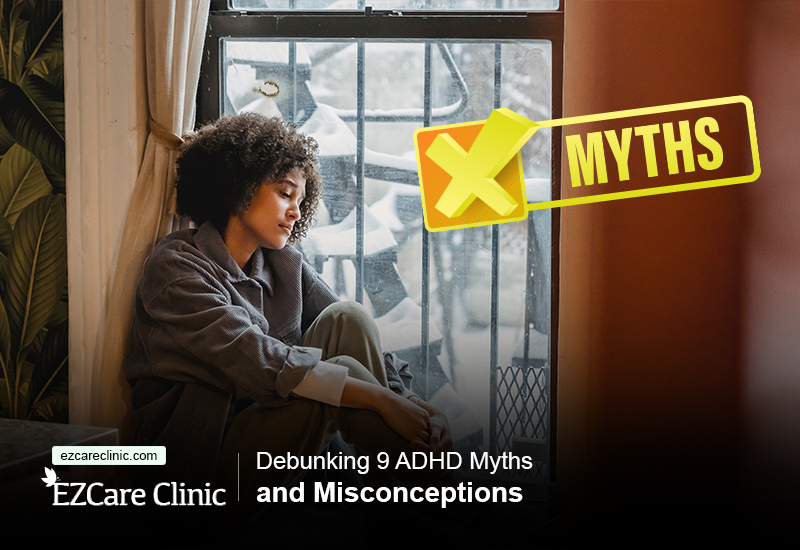Attention Deficit Hyperactivity Disorder (ADHD) has elicited a lot of debate over the years. It has been studied in detail, but its unusual nature has left studies inconclusive. Consequently, some of the information available online is not entirely accurate–and some it is wrong in every aspect.
Regain your mental health by clicking the button below!
ADHD is a prevalent condition that affects millions of people around the world. We should get a better understanding of this condition if we are going to manage and treat it effectively. So, ignore the common myths and misconceptions of ADHD and focus on the facts.
There are nine misconceptions of ADHD that are particularly common and often misleading. Let us start by debunking these myths.
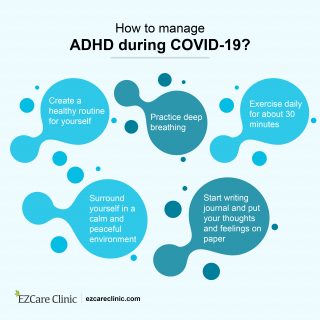
How to Manage ADHD During COVID-19?
1. ADHD is Not a Real Medical Disorder
Some people don’t believe that ADHD is a real medical condition. This misconception is fueled by the lack of biological evidence supporting the condition’s existence. Some people let their fears run wild and claim that ADHD is a big conspiracy created by the pharmaceutical industry.
This misconception, unfortunately, goes beyond ADHD as it is often used against many other psychiatric disorders. It is not true!
ADHD is real for the simple reason that it exists. It is, in fact, one of the most common psychiatric conditions in the world.
-
Fact: There is Sufficient Biological Evidence Supporting the Validity of ADHD
Many medical studies show that ADHD has physical effects on patients’ brains. This alone is sufficient to form a solid neurobiological basis for debunking this myth.
Many studies have shown that ADHD causes some parts of the brain the shrink. It also causes a significant reduction in the gray matter around the brain’s globus palidipus region, according to a consensus reached by seven separate studies conducted in 2008. ADHD Brain scans of various people also reveal cortical thinning in the brain’s frontal regions.
-
Fact: ADHD is Officially Recognized as a Medical Condition
Millions of children around the world are diagnoses with ADHD every year. There were 6.1 million reported cases of ADHD in children in the United States in 2014 alone, according to reports published by the Centers for Disease Control and Prevention. It is also estimated that there were millions of unreported cases partly due to these myths and misconceptions.
ADHD is officially recognized as a medical condition by all major medical organizations around the world. These include the CDC, National Institutes of Health (NIH), and the American Psychiatric Institute, among others.
P.S.
The myth that ADHD is not real is dangerous because it is to blame for the mass ignorance towards the condition. It is important to look past the myth and study the evidence. We can now debunk more myths and learn more about the condition now that the biggest hurdle is out of the way.
Next Move:
There obviously is a lot that people still don’t know about ADHD. Now that we have established that the condition is real, your next move should be learning more about it. That is what we are going to do moving forward.
Visit EZCare Clinic today, get to know about ADHD testing, or simply contact us so that we can help you.
2. ADHD Cannot Be Diagnosed Accurately
It is people’s nature not to believe whatever they cannot see. They believe in medical conditions such as diabetes and cancer because there is visible medical evidence that supports their existence. There is a standard diagnostic procedure applied for each of these conditions, such as taking and measuring blood samples. There also are definite results that confirm the condition’s presence.
People don’t think that there is a standard diagnostic procedure for ADHD. This is true, but only to some degree. ADHD, like most other psychiatric conditions, cannot be tested by taking blood and tissue samples. However, there are several standardized diagnostic procedures.
-
Fact: There is a Universal Standard Protocol for Diagnosing ADHD
There is a standard, universal protocol established for diagnosing ADHD set by the American Psychiatric Association (APA). The protocol, which is spelled out under the APA’s Diagnostic and Statistical Manual (DSM-5), is useful in diagnosing the condition.
The standard protocol has been undergoing review over the years. The current edition is the fifth iteration of the APA’s manual, and it has been revised several times over the past to include new findings and modern medical practices.
The manual lists all known ADHD’s common signs and symptoms. It also covers other related factors that may help in diagnosis and treatment. The signs and symptoms are categorized according to the type and nature of ADHD. Following is a list of some of the criteria and symptoms covered in the manual.
Inattentive Type
Hyperactivity-ADHD Impulsivity Type
- Not paying attention to details
- Making careless mistakes
- Failing to pay attention and keep on task
- Failing to listen
- Being incapable of understanding and following instructions
- Avoiding tasks that require some effort
- Being easily distracted
- Being easily forgetful
- Easily misplacing or losing things
- Fidgeting
- Squirming
- Being incapable of staying seated for long
- Running or climbing at inappropriate times
- Being incapable of playing quietly
- Talking too much
- Blurting out and talking out of turn
- Interrupting others
- Usually on the move as if mechanically driven
The DSM-5 manual states that the following criteria must be followed when using the details listed above to diagnose ADHD:
- There must be at least six symptoms of one type of ADHD in patients aged 16 and below.
- There must be at least five symptoms of one type of ADHD in patients aged 17 and above.
- The symptoms must be present for at least six months.
- The symptoms must be present to an extent whereby they interfere with the patient’s regular functioning and disrupt their everyday lives.
P.S.
There is a third type of ADHD not listed above. It is known as the ‘Combined Type,’ and it affects many people around the world–studies suggest that it is more common than the other individual types. It is characterized by diseases from both of the listed individual types of ADHD.
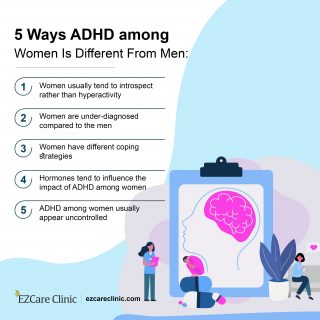
5 Ways ADHD among women is different from men
Next Move:
These are only the basic criteria for diagnosing ADHD and, as such, should not be used as a basis for self-diagnosis. However, you can use them as pointers to help you identify people who may have the condition. It is recommended to consult a doctor if you identify people exhibiting these symptoms.
3. ADHD is Over-Diagnosed
ADHD is becoming more and more prevalent today. Research shows that the number of children diagnosed with the condition has risen by more than 42% from 2003 to 2011. This significant spike in numbers has raised many eyebrows and fueled more conspiracy theories. It has also led some people to believe that the numbers have been doctored by the pharmaceutical industry to suit its agenda.
The misconception that ADHD is over-diagnosed is potentially dangerous. People who believe that Big Pharma is doctoring the numbers may ignore clear symptoms of ADHD or get in the way of their friends and loved ones who have the condition.
Regain your mental health by clicking the button below!
ADHD is not over-diagnosed. Following are several ADHD facts:
-
Fact: ADHD is Actually Under-Diagnosed
ADHD is not over-diagnosed. In fact, research shows that the condition is actually underdiagnosed, especially among girls and adults. This is partly because the condition is under-reported in the U.S. and elsewhere around the world because of ethnic and racial inequalities. It is also believed that the rate of detecting the disease is falsely low.
-
Fact: Diagnosis of ADHD is Regulated Under Strict Guidelines
The standard protocol for diagnosing ADHD has been undergoing improvement over the years. According to the National Survey of Diagnosis of ADHD, the protocol was upgraded in 2014 to include some of the most thorough guidelines. It is also estimated that 90% of ADHD cases undergo strict evaluation and diagnosis.
-
Fact: Diagnosis of ADHD is Reliable
ADHD diagnosis is extremely accurate today compared to the past, and this is measurable. The diagnosis’ protocol’s reliability is measured by having two different doctors make separate diagnostics on one patient and comparing them for similarities and differences. The DSM-5 manual ensures that the diagnosis of ADHD is just as reliable as that of common conditions such as pneumonia.
The increasing prevalence of ADHD is not linked to over-diagnosis. Instead, it has been linked to the increased awareness about the condition amongst the general public.
Next Move:
You can trust the standard ADHD diagnosis protocol to make an accurate diagnosis. Trust the doctors to do their work and do not give heed to the misinformation flying around. Instead, follow up with the doctor closely and monitor the condition’s diagnosis for proper management.
4. ADHD Only Affects Children
Most cases of ADHD indeed involve children, but this does not mean that adults are not immune to the condition.
ADHD has to develop during childhood, as confirmed by research. Doctors believe that the various symptoms of ADHD should be present by the age of 12, according to the new, refined DSM-5 guidelines. However, some of these symptoms may persist in adulthood.
ADHD in kids is usually associated with poor academic performance. It is not much different among adults, but the symptoms are more subtle. ADHD symptoms among adults include poor listening skills, disorganization, tardiness, and trouble upholding social relationships. There is nothing special about these symptoms, so people tend to mistake them with individual shortcomings.
It is unfair to ignore ADHD among adults as irresponsibility and immaturity. The condition is prevalent among adults, too, as supported by the following facts:
-
Fact: ADHD Affects Thousands of Adults
Research shows that about 4.4% of the adult U.S. population has some form of ADHD. This is also true for the rest of the world. In fact, the numbers may be inaccurately low.
Researchers believe that about 65% of children diagnosed with ADHD will go on to exhibit their symptoms even into adulthood. This, however, goes mostly ignored because the symptoms become less severe and apparent with age.
-
Fact: ADHD is More Dangerous Among Adults
ADHD is potentially more dangerous among adults than it is among kids. This is partly because kids with ADHD get adult supervision, which means that they stay out of trouble. Adults with ADHD, however, have no one to help them. They also have expectations and responsibilities that expose them to more dangers. For example, they are at a higher risk of getting into accidents when working or driving.
Research shows that adults with ADHD are at a 50% higher risk compared to children with the condition. They also have an average reduction in their life expectancy by 13 years.
Research also shows that people with ADHD go on to develop other psychiatric conditions in real life. These conditions make ADHD worse and further reduce the patients’ life expectancy rate. They also lead to more life-threatening habits, such as social isolation and substance abuse.
-
Fact: Most Adults with ADHD Go Undiagnosed
Research shows that the prevalence of ADHD among adults increased by 123% from 2006 to 2017. Researchers also report that ADHD is under-diagnosed, despite the spike in the condition’s prevalence. Only about 10% of adults diagnosed with the condition get diagnosed and seek medical help.
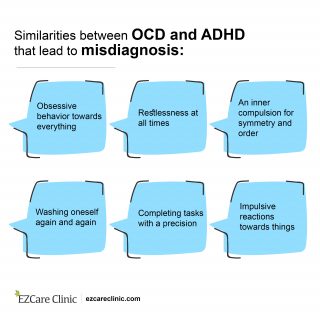
Similarities between OCD and ADHD that lead to misdiagnosis
Next Move:
Most adults with ADHD do not realize it, and so they end up struggling more than they should. This is dangerous as it can lead to premature death. As such, consider whether you exhibit any of the symptoms associated with ADHD and get medical help if you notice any shortcomings. Your doctor will come up with a medical solution to get better control over your life.
5. ADHD Only Affects Boys
ADHD is underdiagnosed among girls and adults, as highlighted earlier. It is true that ADHD primarily affects young boys, but girls are not immune.
ADHD is not as severe or prevalent among girls as it is among boys. This is partly because the symptoms of ADHD are more subtle among girls than they are among boys. Girls with ADHD are less hyper-active than boys, so their symptoms are more difficult to detect and diagnose without a thorough medical examination.
It should also be noted that research on the prevalence of ADHD among girls is inconclusive. However, there is no question that the condition is equally prevalent among both genders in adulthood. The following facts also debunk this misleading myth:
-
Fact: Girls are Just at Risk of Getting ADHD as Boys
Girls exhibit the same ADHD symptoms as boys. Common symptoms among girls include social impairment, poor academic performance, conduct disorder, and oppositional defiant disorder. Girls with ADHD also exhibit a higher risk of suicide attempts and eating disorders compared to boys.
Treat your ADHD symptoms by clicking the button below!
-
Fact: ADHD Symptoms among Girls are Different
Girls share the same ADHD symptoms as boys, but theirs tend to be more subtle or a bit different. For example, girls with ADHD may be more talkative than boys (and they may occasionally interrupt conversations). They also tend to be more emotional and sensitive to seemingly small things.
Girls with ADHD also exhibit more symptoms associated with inattentiveness, while boys mostly exhibit hyperactivity symptoms, according to conclusive findings of 41 studies conducted in 2012. The study also reveals that these symptoms tend to manifest later in life as the girls approach adulthood.
Researchers believe that ADHD is under-diagnosed among girls because of the atypical symptoms. In fact, the condition is often confused with personality traits. To this end, many girls and women with ADHD are often misdiagnosed with anxiety, depression and disability.
Next Move:
ADHD does not discriminate between genders, and the reason why most girls go undiagnosed is the prevailing ignorance amongst the public. As such, it is important to monitor girls you may suspect of suffering having ADHD closely. Many of these symptoms will be atypical, so be keen not to miss anything.
Don’t ignore any of the fairer gender’s symptoms, regardless of how subtle they may be. Get the patients diagnosed as early as possible as the condition is easier to manage at an early age.
Help is only a phone call away. Book your appointment now!
6. ADHD Is Not That Serious
If you know someone who has ADHD, then you probably know people who write them off as being stupid or lazy. Unfortunately, this is the attitude directed towards most psychiatric conditions. People with ADHD especially get it worse because their symptoms are more behavioral in nature than they are medical. This only serves to aggravate their symptoms and makes them feel unwanted and alienated.
Many cultures around the world, including some in the U.S., find it difficult to accept people with psychiatric conditions. This is unfair, as this condition is just as serious as other medical conditions. The following facts are also sufficient to debunk this myth:
-
Fact: People with ADHD Often Suffer from Other Conditions
The Centers for Disease Control and Prevention (CDC) report that nearly 64% of children diagnosed with ADHD are often diagnosed with other behavioral and mental disorders. This is according to research conducted in 2016.
Among other behavioral and mental conditions common among children with ADHD are autism, depression, and Tourette Syndrome. The research also shows that people with ADHD are 1.5 times more prone to substance abuse as they try to cope with the condition. To this end, at least 15% of ADHD patients are habitual drug users.
Research shows that at least one in five ADHD patients has bipolar disorder and is more prone to major depressive disorders. Almost all ADHD patients also deal with an anxiety disorder, which only serves further to aggravate their social shortcomings and other associated symptoms.
-
Fact: Laziness and Irresponsibility Have Nothing to do with ADHD
It is not the fault of ADHD patients appear lazy or irresponsible. It is also not fair to accuse them as such because it only worsens the symptoms.
Criticism of people with ADHD is not constructive. It makes them feel guilty of whatever the ignorant public throws at them, no matter how untrue. The guilt eventually turns into a lack of motivation to overcome their symptoms, which makes these symptoms more severe.
Criticism also lowers the productivity levels of people with ADHD. To this end, they tend to struggle to keep up at work or to manage their finances.
Next Move:
ADHD is more serious than most people realize, and dismissing it as not serious only worsens the symptoms and disrupts the patient’s social, work, and personal life. ADHD patients require help they need, so don’t ignore it–get help as soon as you can to counter the development of other mental conditions such as anxiety and depression.
7. Bad Parenting is to Blame for ADHD
That poor parenting is to blame for ADHD is one of the most outrageous misconceptions about ADHD. Unfortunately, it is a reality.
Society tends to blame parents for the symptoms exhibited by children with ADHD–parents tend to blame themselves as well. For example, kids who tend to throw temper tantrums owing to ADHD are labeled as spoilt. Unfortunately, this happens occasionally in public spaces, such as on the train.
ADHD symptoms are involuntary, so neither the patient nor the parents are to blame. The following facts prove this:
-
Fact: ADHD is a Genetic Disorder
ADHD is as much a genetic disorder as it is a mental condition. Parents with ADHD are four to nine times more likely to give birth to children with the condition, according to overwhelming evidence from studies by researchers from Cardiff University.
Scientists are yet to pinpoint the individual genes that cause ADHD. The one common genetic trait among people with ADHD is missing DNA sequences.
-
Fact: Strict Parenting is Not Sufficient to Treat ADHD
Sometimes parents blame themselves for their children’s behavioral challenges. The frustration also causes them to falsely blame their ADHD kids and punish them, hoping that they will change. This never works – instead, it only creates a rift between the parent and child and worsens the symptoms.
Kids with ADHD need more support and supervision from their parents as a gentle approach will work better than punishment. Parents of kids with ADHD may need to take extra parenting classes for parents of kids with special needs.
-
Fact: There are Many Other Valid Causes of ADHD
There are many other real causes of ADHD. For example, certain hormones such as dopamine and noradrenaline contribute to ADHD when not balanced. Other hormones and brain chemicals may also cause a reduction in the brain’s grey matter, which is a common sign among people with ADHD.
The environment in which a child is brought up can also slightly contribute to the condition. The effects, however, are very mild, and the research is still inconclusive.
Next Move:
Don’t let anyone make you feel guilty about your child’s problem with ADHD. It is counterproductive, and it will end up hurting you both. Instead, look into ways to be more supportive. For example, create the ideal environment at home where your child can feel safe and calm. You should also exercise more patience and understanding when parenting and create a stronger bond between you two. Make your child feel loved, and they will start getting better control over their condition.
8. Watching Too Much T.V. Causes ADHD
TV has been blamed for many of the children’s developmental problems, including some of the symptoms of ADHD. This is true, but only to a certain degree.
Attention deficiency is one of the common symptoms of ADHD, and watching too much T.V. is proven to reduce your attention time span. This is because the fast motion pictures over-stimulate neural centers associated with sight and sound. Over-stimulation makes these neural centers less responsive to ordinary stimulants, which means that you have to put in more time and effort to concentrate on more important things.
One study, in particular, has directly linked watching too much T.V. to ADHD. The study, which was conducted in 2004 by the Children’s Hospital for Seattle, concludes that exposing kids aged between one and three reduces their attention period by the age of seven. It is also thought to contribute to some of the other symptoms of ADHD.
There is no doubt that watching too much T.V. is unhealthy. However, it is not so bad that it would cause ADHD, as proven by the following facts:
-
Fact: The Existing Evidence is Inconclusive
Researchers from the Children’s Hospital for Seattle admitted that their 2004 study on the effects of T.V. on ADHD was inconclusive. Attention deficiency affects everyone who watches too much T.V., including kids without ADHD. Additionally, many of the symptoms discussed in the study are generic and not necessarily related to ADHD.
Click the button below to get effective ADHD treatment!
-
Fact: T.V. Viewing Habits among Kids with ADHD are Not Exceptional
Several related studies have also validly concluded that exposure to T.V. could not cause ADHD. One particular study, which was conducted by the Texas Tech University in 2006 and involved more than 5,000 kids, disputed this deep-seated misconception using comprehensive and conclusive data.
Several studies have also revealed that there is no difference in the T.V. watching habits of kids with ADHD and those without. Kids on both sides of the spectrum spend almost equal amounts of their time watching T.V., according to one study conducted in 2007.
Next Move:
Billions of children worldwide spend most of their time watching T.V. and have never been diagnosed with ADHD, while some kids diagnosed with the condition have limited access to the blue screen. Watching too much T.V., while not a risk factor for ADHD, is still not healthy. As such, it is advisable to limit your kid’s screen time and come up with fun, creative, and healthy alternatives.
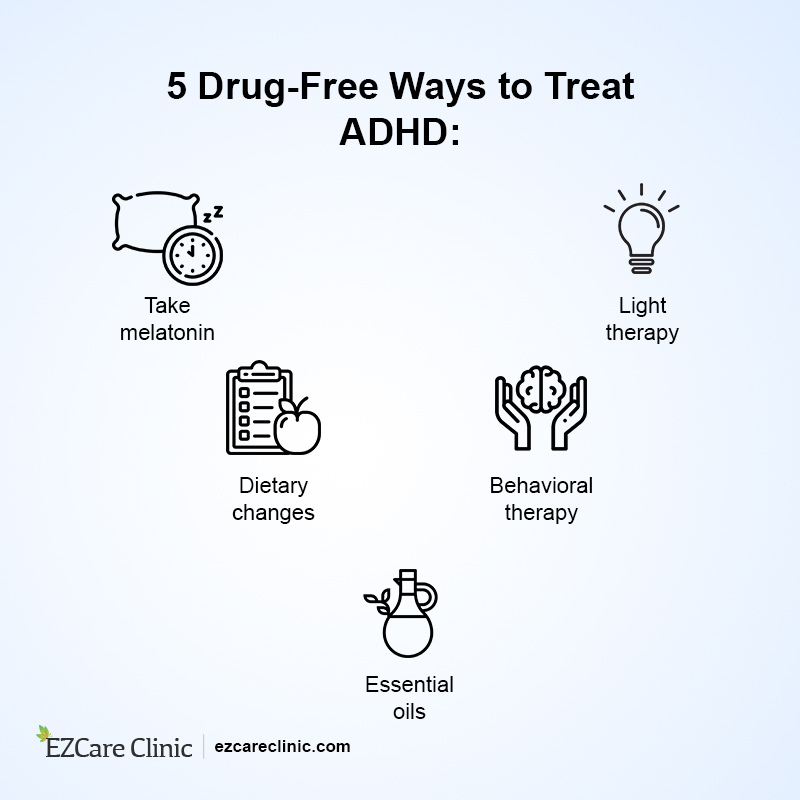
Treat ADHD Naturally
9. ADHD Doesn’t Require Medication
This is one of the other most dangerous misconceptions about ADHD. It stems from other misconceptions, such as the belief that ADHD is not real or that it is tied to an individual’s personal shortcomings. This myth is so rife that the CDC estimates that more than 23% of people diagnosed with ADHD do not receive the needed medical treatment.
The behavioral nature of ADHD has led many people to believe that the condition can be fixed using behavioral therapy. Certain behavioral techniques have been proven to work, but they are not as effective as medical treatment.
ADHD is treated using a common and popular drug known as Ritalin (methylphenidate). This drug works by stimulating certain regions of the brain to increase the patient’s attention time span. The patient can then control other symptoms, such as hyperactivity, as a result of increased attention span.
Ritalin, unfortunately, is often abused for non-medicinal purposes. For example, it is popular among students who take it to help them study for their exams. To this end, the drug is considered a high-risk factor for drug abuse and has courted a lot of controversy on the subject since the 1960s. This has attracted so much attention that it has distracted from the drug’s main purpose: treating ADHD.
The controversy around ADHD medication doesn’t make it any less effective, as proven by the following facts:
-
Fact: Medication Is Effective In Controlling Some Symptoms of ADHD
Ritalin, as mentioned, is effective against some of the symptoms of ADHD, and primarily against attention deficit. Its benefits include increased productivity. It can also increase the patients’ life expectancy because ADHD is linked to higher morbidity and mortality rates among untreated patients. This is according to numerous studies conducted by the CDC and other relevant authorities.
The CDC reports that up to 80% of children under medical treatment exhibit fewer symptoms compared to those not under treatment. They are also better capable of managing the condition as they grow.
-
Fact: Medical Treatment of ADHD Lowers the Risk of Substance Abuse
ADHD patients, as mentioned before, often do drugs in a bid to cope with their condition’s challenges. Consequently, patients who undergo treatment to suppress and manage their symptoms are at a lower risk of turning to illicit drugs for solace.
Several studies have supported this conclusion. One particular study conducted in 2014 provides the most conclusive evidence. The study involved two groups of 60 people with ADHD. Group A had 30 patients who were undergoing ADHD medical treatment, while Group B had 30 patients without treatment.
The patients in Group B registered significant substance abuse diagnoses, and their lives were more chaotic compared to patients in Group A. Their woes included higher unemployment rates, the need for frequent compulsory care, and chaotic social lives without meaningful relationships.
Visit EZCare Clinic today, or simply contact us so that we can help you.
Next Move:
Medical treatment is the most effective way to manage ADHD. Ritalin is effective in more than 80% of ADHD cases, but it is not the only option. Other effective drugs include Atomoxetine and certain supplements.
ADHD drugs should only be taken under prescription, so consult a psychiatrist first. Most ADHD drugs have mild side effects and lasting long-term benefits.
P.S.
Ritalin is known to have harmful side effects when taken excessively without prescription. It is, however, safer for people with ADHD.
Final Word
ADHD is not properly recognized as a valid medical condition in society. To this end, patients with ADHD often find difficulty gaining acceptance in their communities. They have to deal with constant criticism and unfair judgment. This is not only wrong but also potentially dangerous as it only makes certain symptoms worse, including pushing patients to do drugs and fueling suicidal thoughts.
It is time for the world to look past its ignorance and recognize ADHD as a serious condition. This will start with more and more people raising awareness about the condition and its facts and misconceptions. This guide should suffice as a starting point, but your campaign shouldn’t end there as there is still a lot to learn about the condition.
Most importantly, it is important to give ADHD patients the help they need. The challenges of coping with ADHD, including limited social interaction and poor academic performance, have adverse effects on patients’ everyday lives. These effects, however, are less pronounced with the proper treatment and management. As such, support them as they try to cope with the condition and consult a psychiatrist to get them on Medication as early as now!
Regain your mental health by clicking the button below!
Let Us Help
Do you know a friend or loved one living with ADHD? Get them the help they need today by consulting a psychiatrist.
EzCare Clinic is here to help! We have dedicated our careers to caring for people with ADHD and a variety of other conditions. We have plenty of experience and expertise in the field, including a team of some of the most trusted medical professionals in the industry.
Get in touch today and let us know what the patient is going through. Our psychiatrists will perform a comprehensive medical evaluation and prescribe the ideal treatment regimen. Help is only a phone call away. Book your appointment now!
